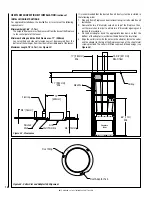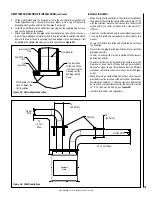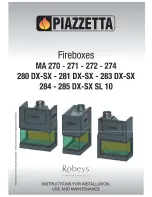
NOTE: DIAGRAMS & ILLUSTRATIONS ARE NOT TO SCALE.
5
Accelerated Combustion
The maximum heat output for the fireplace is
achieved by burning with the combustion air
damper opened (
see
Figure 2
)
. By this method,
the fireplace can produce up to 70,000 BTU of
heat per hour. However, it will be necessary
to reload with wood every one or two hours.
This is the least efficient method of burning
the fireplaces.
Figure 2 - Accelerated Combustion
Slow Combustion
When the air combustion damper is almost
closed, the fireplace is in a slow combustion
phase (
see
Figure 4
)
. Slow combustion will
not stop the fire, but there will be a noticeable
change in the flame pattern. The flames will
be slow and may appear dirty if the wood is
too wet (moisture content of 20% and more).
Always set the damper so that flames are
visible , that way you maintain a good clean
combustion process.
Figure 3 - Medium Combustion
For instance, a long chimney will necessitate
closing the damper more. To obtain the proper
combustion, close the damper completely, then
open it about 1/2 to 3/4. Three medium size
pieces of wood should be burning on a bed of
hot coals. The heat output will be approximately
35,000 BTU per hour and the loading time will
be about every 3-4 hours. Softwoods may be
burned using this method but the time will be
substantially reduced.
Use caution when firing with the combustion
air control wide open. Only burn cordwood in
this manner. Small dry pieces of softwood and
construction scraps will burn very intensely
using this method and may damage the firebox
and catalytic combustor.
Medium Combustion
This is the recommended mode of operating
the fireplaces and should be the one normally
used since it will deposit the least amount of
creosote on the glass and in the chimney. The
combustion air damper must be 3/4" closed
(
see
Figure 3
)
. The precise setting will depend
on many factors, including chimney length and
the moisture content of the wood.
This method of burning should be used only
after operating the fireplace with the air control
opened to produce a hot fire for about an hour.
Slow combustion can be used at night in order
to reduce the heat output and prolong the burn.
The loading time will be between 6-10 hours.
Be aware that the glass will get dirty using
this setting.
Starting And Maintaining a Fire
Step 1.
Place several crumpled up balls of
newspaper in the firebox. Place small dry pieces
of kindling on top of the paper, criss-crossing the
kindling so that there are air spaces in between.
Keep the fuel far back enough so that air can
get underneath.
Figure 4 - Slow Combustion
Step 2.
Open the air control fully and pull the
by-pass damper control towards you to put it in
the OPEN position. Light the newspaper. Leave
the door open until the fire is well established.
Step 3.
Once the kindling fire is well estab-
lished, add increasingly larger pieces of cord-
wood until the fire is actively burning. Close the
door and maintain an accelerated combustion
air set up in order to achieve combustor light-off
conditions.
Step 4.
When the fire is burning well, close the
by-pass damper control by pushing the control
rod in. It takes about 15 – 30 minutes with
the by-pass opened to reach proper light-off
temperatures for the catalytic combustor.
Step 5.
Set the air control at the desired setting.
The unit will burn best with 2-3 pieces of cord-
wood spaced 1 to 2 inches apart and allowing
air to get under the fuel. Criss-crossing or ar-
ranging the fuel so that air can get underneath,
will help the fire get started easily.
Refuelling for Best Performance
(see Figure 5
)
To refuel the
fireplace at the end of a burn cycle
when only hot embers remain and flames are
gone (not enough heat to maintain catalyst
operating temperatures):
Step 1.
Open the by-pass and air controls fully.
Step 2.
Open the door approximately 1 inch
and wait five seconds until the draft is
stable. Then open the door completely,
load the fuel and close the door.
Figure 5
Open
Closed






































